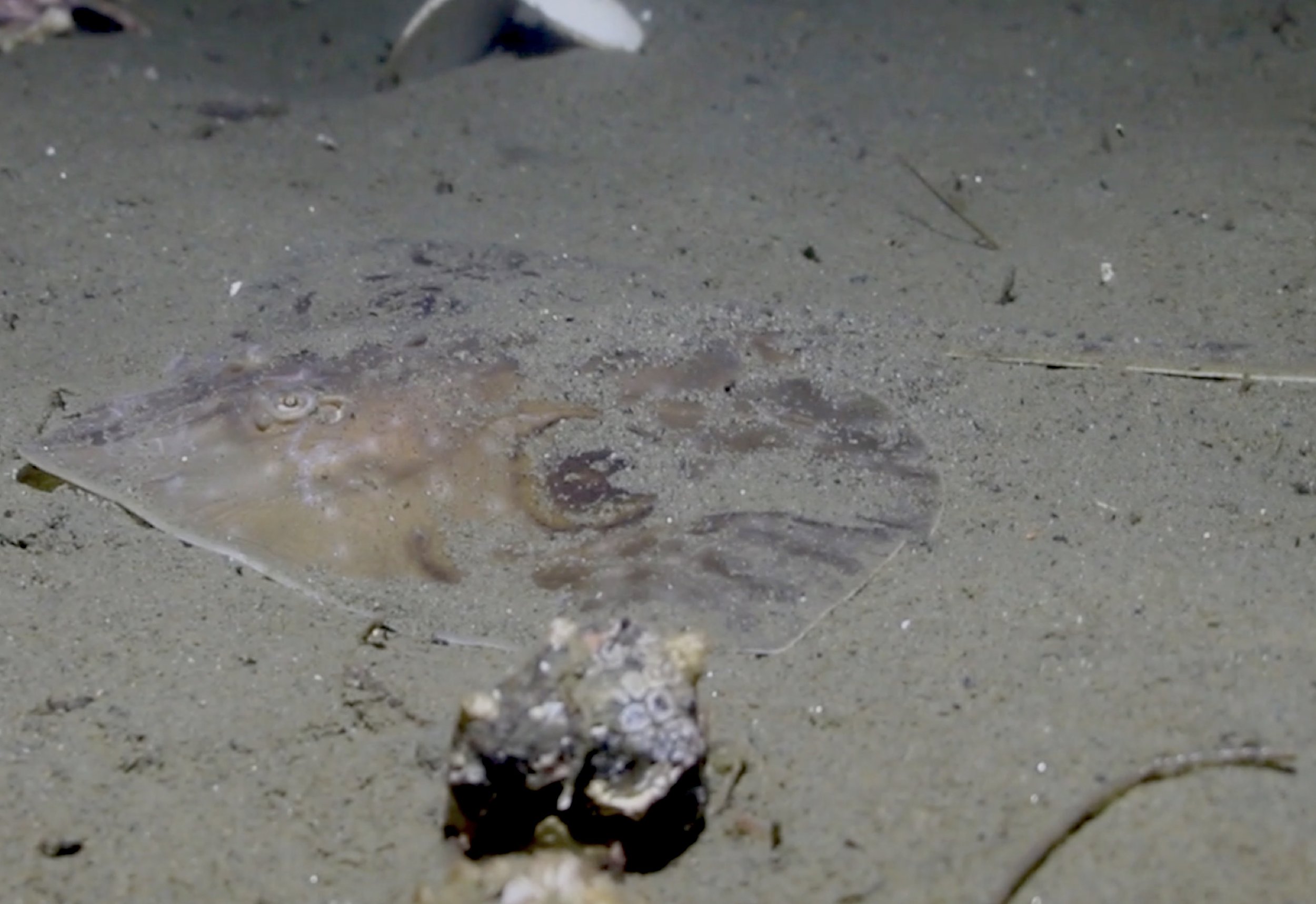Big Skate
Beringraja binoculata
On social media channels, the Big skate is recognized more frequently from below than it is above. In its natural habitat, skates are shy and very much prefer to keep their vulnerable bellies as close to the seafloor as possible. In aquariums and research facilities however, juvenile skates are known for their curious habit of playfully bobbing up and down along the glass of their tank, revealing to viewers a cartoonishly-silly grin and two stubby little feet. The Ucluelet Aquarium frequently displays newborn Big skates, which is where the source material for this artwork originated. I would like to extend a big thank you to the Ucluelet Aquarium team for allowing me to use this image, as capturing a photo of a skate belly in the wild would be next to impossible. This image can be seen below:
March 2022: A juvenile Big skate curiously glides along the glass of its tank, displaying its scientifically adorable characteristics. Photographed at the Ucluelet Aquarium in Ucluelet, B.C.
📖 Description 📖
Big skates are big. Growing up to a total length of 2.4m and weighing up to 91kg, this species holds the title of the largest skate in the Northeast Pacific [1]. Other than while fishing, the Big skate is very rarely spotted by naturalists. I myself have only ever encountered a single skate in the wild; an experience I have since longed to repeat. Skates are an interesting family of fish that are closely related to manta rays, sting rays, and electric rays. Like all cartilaginous fishes, sea skates don’t have a single bone in their body, as their entire skeleton has been replaced with cartilage. Big skates can be quickly identified from above, as they are the only local species that features two large, black spots on either one of their wings. To predators, these black spots look like a pair of big, scary eyes which make the Big skate look much larger, and much more threatening than it actually is.
December 2019: A juvenile Big skate patrols a shallow Sea pen garden under cover of darkness. Photographed in Central Saanich, B.C.
🌎 Distribution 🌎
The Big skate has been observed as far north as Central Alaska and the Aleutian Islands and as far south as Baja California and the Sea of Cortez [2]. While its distribution may initially appear impressive, Big skates need cold water to survive. As one moves south along their distribution, they are only found in increasingly deeper water. In Alaska, Big skates have been seen as shallow as the Intertidal zone, while in Baja California they are restricted to the deep sea.
Distribution of the Big skate, Raja binoculata. Suitable habitat depicted in red.
🏝 Habitat 🏝
Typically, Big skates prefer to live in sand and mud in cold, deep water, where they patrol the seafloor in search of prey. When at rest, they will bury themselves in the sand leaving only their eyes exposed to watch their surroundings. Little is known about their behaviour. However on rare occasions, large numbers of Big skates have been spotted in relatively shallow waters by scuba divers. These events may be tied to this species’ lifecycle, as it has been reported that mermaid purses (egg cases) have been found in the area after the skates have moved on [3].
Depth of suitable habitat for the Big skate, Raja binoculata. Suitable habitat depicted in red. Not to scale.
🦀 Diet 🦀
Big Skates consume a variety of prey, including worms, crabs, clams, and shrimps. As Big skates prefer habitats with soft bottoms, it is no surprise that they preferentially feed on the types of animals that can be found by digging through sand and mud [3].
January 2020: A fleshy scale worm, one of many potential species that the Big skate may prey upon. Much like the Big skate, this species is only seen in the open at night. Photographed in Brentwood Bay, B.C.
🦈 Life Cycle 🦈
Sea skates have a curious means of reproduction. Instead of laying eggs like most fish, or giving live-birth, Sea skates instead produce something known as an ‘egg case’. These capsules are also known as Mermaid purses, and are quite often found washed up on the beach along exposed coasts, such as those on the west coast of Vancouver Island. In most cases, the young inside the mermaids purse hatch by the time it reaches the shoreline. In each of these egg cases, there can be up to 7 skates, which develop and cut themselves out of the mermaid’s purse after 9 months of development [4].
December 2019: The same Big skate pictured above was startled, and began rapidly darting towards deeper water. The two large eyespots on either wing can be seen here. Photographed in Central Saanich, B.C.
📚 References 📚
[1] Fishbase. (n.d.). Beringraja binoculata (Girard, 1855) Retrieved March 20, 2023, from https://www.fishbase.se/summary/Raja-binoculata.html
[2] World Register of Marine Species. n.d. Raja binoculata (Girard, 1855) Retrieved March 20, 2023, from https://www.marinespecies.org/aphia.php?p=taxdetails&id=271572
[3] IUCN/SSC Shark Specialist Group (2005). Sharks, Rays and Chimaeras: The Status of the Chondrichthyan Fishes. IUCN. ISBN 2-8317-0700-5
[4] McFarlane, G.A. & King, J.R. (2006). Age and growth of big skate (Raja binoculata) and longnose skate (Raja rhina) in British Columbia waters. Fisheries Research. 78(2–3):169–178. doi:10.1016/j.fishres.2006.01.009






